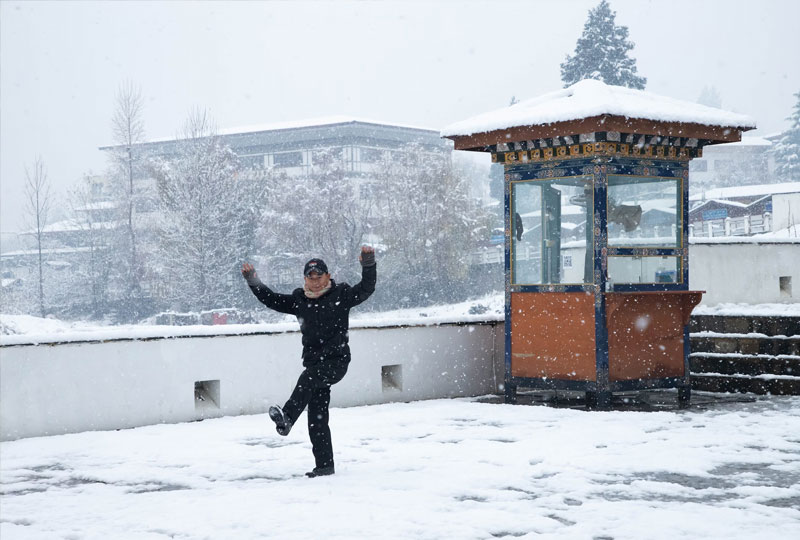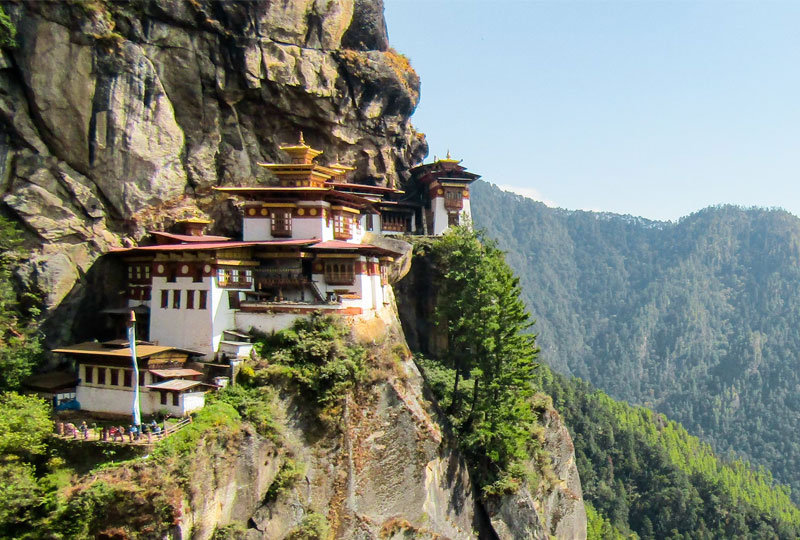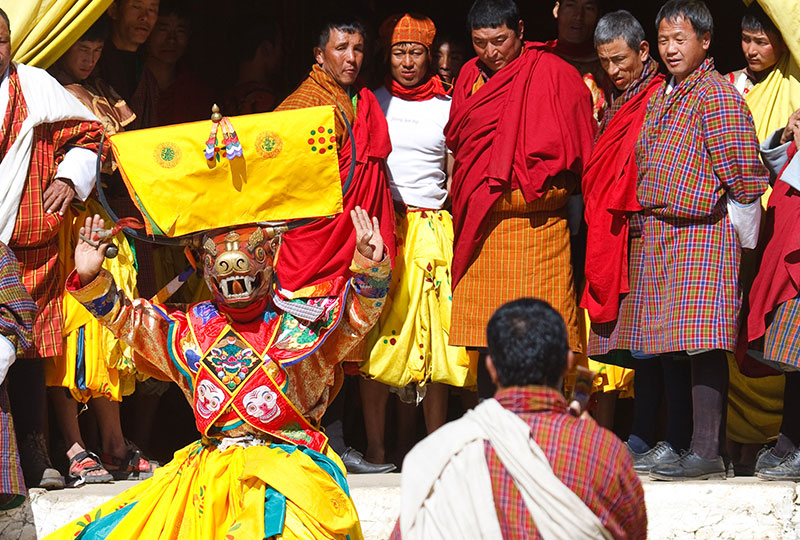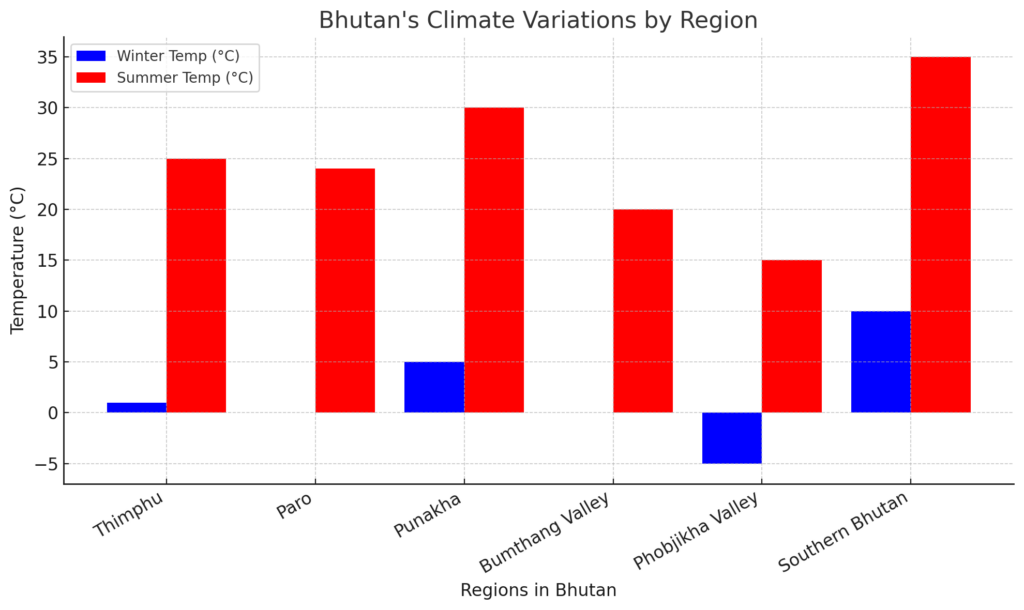Known as the Land of Thunder Dragon, Bhutan is a peaceful country in the lap of the himalayas. It is a dream destination for travelers seeking vibrant landscapes, lively culture, and spiritual experiences. Bhutan’s commitment to sustainable tourism enhances its attraction and ensures every traveler has meaningful and sustainable travel experiences. So, choosing the right time is very important to enjoy fully and make your Bhutan trip successful.
The best months to visit Bhutan are March to May and September to October. During these months, the weather is favorable, and the hillsides are adorned with blooming rhododendrons and lush greenery. However, other seasons provide unique experiences for travelers in Bhutan. You can plan an adventurous trek or hike in the spring and autumn, as the weather is favorable and clear. Likewise, you can enjoy sightseeing, snowfall, and photography during the summer and winter.
Further, by aligning your Bhutan travel with the best season, you can enjoy the perfect natural landscapes and lively celebrations of Bhutanese festivals.
Seasonal Guide to Bhutan
Bhutan has four seasons: Spring, Autumn, Winter, and Summer. Each period offers different weather conditions.
1. Spring Season (March, April, and May)
The spring season begins in March, transforming Bhutan’s landscapes with vibrant blooms of rhododendrons and magnolias. The weather is constant and pleasant with clear skies and blooming hues. Additionally, it is the perfect time for outdoor activities like hiking and sightseeing. Similarly, this is also a festive time and visitors can participate in major bhutanese festivals like Paro Tsechu.
Furthermore, trekkers who visit Bhutan during spring to explore its landscapes can fully enjoy it, as the trails are adorned with vibrant flowers and clear mountain views. Overall, it is the best season to immerse yourself in the festive atmosphere and enjoy the panoramic views.
2. Autumn Season (September, October, and November)
Autumn is one of the best seasons to visit Bhutan, as the weather is mild and the skies are clear. During this time of the year, visitors can enjoy the mesmerizing views of the snow-capped peaks. The crisp, bright, and cool weather makes it perfect for sightseeing and hiking. Additionally, visitors can immerse themselves in a festive atmosphere like Thimpu Tsechu.
3. Summer/Monsoon (June, July, and August)
During the summer/monsoon season, there will be heavy rainfall in Bhutan especially in the southern part. The heavy rain makes the weather humid and transforms Bhutan’s landscapes and valleys into lush greenery. Also, the weather is best for nature enthusiasts and photographers as the country becomes alive with fresh vegetation.
Further, heavy rainfall can make trails slippery, so outdoor activities such as hiking are not recommended. However, visitors seeking a peaceful retreat can enjoy the serene nature and blooming landscapes.
4. Winter Season (December, January, and February)

The winter season in Bhutan lasts from December to February. The weather is cold, and there will be heavy snowfall during this season. Also, the skies are clear, and it offers an amazing view of the snow-capped peaks. Compared to higher valleys, the lower valleys remain warmer, creating a perfect balance of comfort and low temperature.
Furthermore, the winter season is perfect for visitors who love peace and for cultural exploration away from huge crowds. Similarly, tourists exploring snowy landscapes can visit high-altitude destinations such as Bumthang Valley and Haa Valley. In contrast, if you love sightseeing and outdoor activities, lower-altitude destinations like Punakha and Paro are perfect to visit during these times.
Here is the tabular overview of temperature variations throughout the different months of the year:
| Months | Temperature Range |
| March-May | 10°C to 25°C (50°F to 77°F) |
| June – August | 15°C to 30°C (59°F to 86°F) |
| September – November | 10°C to 25°C (50°F to 77°F) |
| December – February | -5°C to 10°C (23°F to 50°F) |
Best Time to Visit Bhutan
1. Spring Season (March, April, and May)
Spring is one of Bhutan’s peak tourist seasons, as the weather is warm and pleasant, with low humidity and a clear environment. This season is perfect for exploring the hillside and doing outdoor activities. During this time, the hills are adorned with vibrant rhododendrons and wildflowers. Also, travelers can participate in Bhutan’s popular, colorful festivals, including Paro Tsechu. Overall, spring provides the best combination of pleasant weather, natural beauty, and cultural experiences.
2. Autumn Season (September, October, and November)
Autumn is another best time to explore Bhutan. The season begins after the monsoon, so the weather during this month is crisp, cool, and clear, with favorable temperatures. September, October, and November are the best months to visit Bhutan, offering a picturesque view of snow-capped peaks and lush vegetation. Additionally, autumn is also the festive season in Bhutan, and visitors can enjoy the Thimpu Tsechu festival. Overall, the clear weather and constant weather conditions make it easier to trek in Bhutan.

Comparisons between Spring Season and Autumn Season
Spring (March, April, and May) and Autumn (September, November, and December) are Bhutan’s peak tourist seasons because of their favorable weather conditions and blooming landscapes. In spring, travelers can enjoy vibrant landscapes and lively festive vibes, while in autumn, visitors can enjoy clear skies and amazing snow-capped mountain views. In conclusion, both seasons make the perfect conditions for outdoor activities, sightseeing, cultural exploration, and trekking.
Traveling in Bhutan During the Off-Season
While the high seasons, Spring and Autumn, are perfect for the perfect weather conditions and festive atmosphere, traveling to Bhutan during the off-season offers unique and memorable experiences. During the peak tourist season, small Bhutanese cities and monasteries are crowded with visitors. However, off-season travel in Bhutan allows you to explore the sites, dzongs, and trails peacefully. Additionally, some tour operators provide discounts during the off-season and make travel budget-friendly.
1. Winter Season (December-February)
Despite being the coldest season, winter in Bhutan brings a memorable experience with crisp and snowy weather. During this period, travelers can enjoy the clear skies and photogenic views of the snow-capped peaks and valleys. It is also the perfect season for visitors who love nature and bird watching, as, during this period, the rare black-necked cranes migrate to the Phobjika Valley. Visitors can immerse themselves in local celebrations like the Punakha Drubchen Festival, which showcases Bhutan’s historic battles with Tibetan invaders.
Furthermore, while the weather in higher altitudes can be cold with low temperatures, lower regions including Paro and Thimpu can be manageable with proper preparation.
2. Summer Season (June-August)
The summer/monsoon brings lush greenery and blooming landscapes, especially in the hillsides and mountains. Similarly, the season is perfect for visitors who are nature enthusiasts and photography lovers. The rainfall enhances Bhutan’s scenic beauty and makes it ideal for peaceful traveling.
Moreover, heavy rainfall is common during the monsoon, particularly in southern Bhutan. However, with proper gear including a raincoat, sturdy shoes are needed for staying comfortable and making the journey memorable.

Special Festivals to Plan Around While Traveling Bhutan
Deeply rooted in Buddhism, Bhutan’s lively celebrations of Tsechu allow travelers to participate in festivals celebrated for ages. Similarly, the Bhutan festive calendar is filled with vibrant celebrations that feature sacred mask dances, rituals, and local gatherings.
Here is the list of some of the popular festivals in Bhutan below:
| Festivals | Months | Destination |
| Paro Tsechu | March/April | Paro Valley |
| Thimpu Tsechu | September/October | Thimpu |
| Jambay Lhakhang Drup | October/November | Bumthang |
| Punakha Drubchen | February/March | Punakha |
| Black-Necked Crane festivals | November | Phobjika Valley |
| Haa Summer Festival | July | Haa Valley |
Further, planning your Bhutan travel during these Bhutanese festivals provides insight into the country’s deep connection with Buddhist traditions and practices. These celebrations are lively and colorful adorned with traditional music, dances, and the gatherings of the local community. Also, during the festival, travelers can connect with the locals and get an opportunity to learn about the customs in depth. Similarly, photographers can capture eye-catching performances, costumes, and festive crowds for a long-lasting memory.
Bhutan’s Trekking Seasons
Bhutan has some of the most adventurous trekking experiences in the world. The trail of Bhutan ranges from easy cultural treks to adventurous high-altitude trekking. The best time for Bhutan treks is Spring (March to May) and Autumn (September to November). The trail is adorned with blooming landscapes, pleasant temperatures, mesmerizing snow-capped peaks, and vibrant rhododendrons during this period.
Further, trekkers can do some of the popular treks including the popular Snowman Trek, which is one of the most adventurous high-altitude trails in the world, the Druk path trek, which connects Paro and Thimpu and Jomolhari Trek, where trekkers can immerse themselves in local cultures and amazing mountain views. Additionally, you must consider the perfect weather and fitness level while choosing which treks to do. Some of the tips for selecting a trek based on weather conditions in Bhutan are listed below:
- You can choose trails like Druk Path and Jomolhari Trek during spring for vibrant landscapes, blooming wildflowers and rhododendrons, and mild temperatures.
- Trekkers should skip the trek during the summer/monsoon season as the trail can be slippery and less visible.
- While doing adventurous and challenging treks, allow time to adjust to higher altitudes.
- You must pack layered clothes, essential gear, and sturdy hiking boots.
Are you planning to extend your tour?
For travelers looking for an extended tour that offers the best of the Himalayas landscapes and natural beauty, the Nepal and Bhutan tour lets you explore the serene land of Bhutan with Nepal’s rich cultural heritage and bustling cities.
Bhutan’s Climate and Regional Variations
Bhutan’s altitude and climate highly impact its weather pattern across the country. And the temperature varies from different regions. Here is a short description of the types of climate in different parts of Bhutan:
| Region | Altitude (m/ft) | Winter Temp (°C) | Summer Temp (°C) | Climate Features |
|---|---|---|---|---|
| Thimphu | 2,320m / 7,612ft | 1°C | 25°C | Cool winters, mild summers |
| Paro | 2,200m / 7,218ft | 0°C | 24°C | Similar to Thimphu, clear skies in autumn |
| Punakha | 1,200m / 3,938ft | 5°C | 30°C | Subtropical, mild winters, warm & humid summers |
| Bumthang Valley | 2,600m – 4,000m | 0°C | 20°C | Cooler climate, can be harsh in winter |
| Phobjikha Valley | 3,000m / 9,843ft | -5°C | 15°C | Chilly year-round, significant summer rainfall |
| Southern Bhutan | Below 300m | 10°C | 35°C | Hot & humid, heavy monsoon rains |
1. Climate in Thimpu
Thimpu, the capital city of Bhutan, is nestled at an altitude of 2,320m/7,612ft and encounters the coldest temperature drop up to 1°C in winter. Conversely, the temperature rises to 25°C during the summer season.
2. Climate in Paro
Paro, situated at an elevation of 2,200m/7,218ft, shares similar weather conditions as Thimpu with favorable temperatures. It offers clear skies and vibrant landscapes during the autumn and is perfect for trekking and sightseeing.
3. Climate in Punakha
Further, Punakha, located at a lower altitude of 1,200m/3,938ft, has a subtropical climate. So, the weather is mild during the winter and warm and humid in summer, with the temperature rising to 30°C.
4. Climate in Bumthang Valley
Continuing towards the east to Bumthang Valley, at an altitude of 2,600m-4,000m, the temperature remains lower the whole year. Similarly, the weather could be harsh, with temperatures dropping to 0°C in winter.
5. Climate in Phobjika Valley
Moreover, the Phobjika Valley, situated at an elevation of 3,000m/9,843ft, remains chilly throughout the year. Compared to the southern part of Bhutan, the area is located above 300 m has a hot and humid climate, and has significant rainfall during the summer season.
Bhutan’s Climate Chart

Here is a climate variation chart for Bhutan, showing winter and summer temperatures across different regions. Let me know if you need any modifications!
Travelers must know Bhutan’s diverse weather conditions and pack accordingly for a rewarding journey. Some of the packing tips are listed below:
- Layered Clothing: You need to pack clothes for the changing weather pattern of Bhutan, particularly if you are traveling to different destinations.
- Windproof Jackets and Thermals: If you are planning your visit during the winter, these are required for higher elevation regions.
- Rain Coat/ Gear: You must pack rain gear, including a raincoat, umbrella, and waterproof jackets for the monsoon seasons.
- Sun Protection and Hats: Don’t forget to pack sunscreen, lip care, and a hat to protect yourself from sun exposure.
Tips for Planning Your Trip to Bhutan
Some of the major tips to plan your trip to Bhutan for a safe and memorable journey are listed below:
- During Bhutan’s peak seasons (Spring and Autumn), book your permits and accommodation early through licensed tour operators.
- Visitors must pay a $100 Sustainable Development Fee daily to support Bhutan’s sustainable tourism.
- The weather can change frequently, so visitors must pack proper clothing and gear to make the trip comfortable.
- You must respect bhutanese customs by dressing modestly, following the guidelines, and avoiding touching sacred objects.
- Visitors can plan their tour around festivals. You can check the Bhutan festival calendar and align your visit during the festive time.
- You can explore monasteries, dzongs, and religious sites like Tiger’s Nest Monastery for in-depth learning about Buddhism.
- Lastly, book your visit through licensed bhutanese tour operators for better arrangements, including visas, itinerary, and expert guidance.
Conclusion
The best time to visit Bhutan is Spring(March to May) and Autumn (September to November) when the weather is constant and favorable with clear skies. You can also plan your trip in the off-seasons, Summer (June to August) and Winter (December to February), for a peaceful and solitude experience with extra consideration.
Similarly, if you love trekking, exploring local culture and traditions, or enjoying peaceful nature, align your visit with Bhutan’s best months and festivals. This will make your trip memorable and immersive. You can also check out these Bhutan Tour Packages and plan a memorable visit to Bhutan.
Further, our dedicated Bhutan experts are always ready for you to customize your trip according to your preferences for a hassle-free visit. Connect with us today to make your trip to Bhutan memorable!
